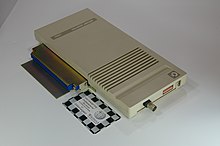ARCNET
ARCNET, an acronym for Attached Resource Computer NETwork, was a local area network architecture that uses the pass-through access technique. witness, such as Token Ring.
It was developed by Datapoint Corporation, in 1977.
Also known as CamelCased, ARCnet, ARCANET.
The physical topology is in the form of a star, while the logical topology is in the form of a ring, using coaxial cable and concentrators (hub) passive (up to four connections) or active.
Features
- Although they use bus topology, a concentrator is usually used to distribute the workstations using a star setting.
- The cable used is usually coaxial, although the braided pair is the most convenient to cover short distances.
- Use the method of witness passage, even if physically the network is not in the ring. In these cases, each machine is given an order number and a ring simulation is implemented, in which the token use such order numbers to guide.
- The cable uses a rotating BNC connector.
Speed
The transmission speed was around 2 Mbps, although since there were no collisions the performance was comparable to that of Ethernet networks.
The speeds of their transmissions are 2.6 Mbits/s.
Supports lengths up to 609 m (2000 ft).
History
ARCNET is a local area network (LAN) protocol, similar in purpose to Ethernet or Token Ring.
ARCNET was the first widely available networking system for microcomputers and became popular in the 1980s, for office automation tasks.
Originally, ARCNET used RG-62/U coaxial cable and passive or active hub in a star-wired bus topology.
At the time of its greatest popularity, ARCNET enjoyed two important advantages over Ethernet:
- the bus star-wired, it was much easier to build and expand (and was more easily conservable) than linear Ethernet.
- cable distance, ARCNET coaxial cable operation could be extended to 610 m (2000 ft) between the hubs assets or between Hub active and a final node, while the final Ethernet of the RG-58 used as extensively as possible at that time was limited to a maximum operation of 183 m (600 ft) from the end to the end.
Of course, ARCNET required an active or passive hub between nodes if there were more than two nodes on the network, while Ethernet eventually allowed nodes to be spaced anywhere along the coaxial cable. linear, although ARCNET's passive hubs were very cheap.
To mediate bus access, ARCNET uses a token-passing scheme, slightly different from that used by Token Ring. When the peers are idle, a single "token" it is passed around the network from machine to machine, and no peer is allowed to use the bus unless it has the symbol. If a particular peer wants to send a message, it waits to receive the token, sends its message, and then passes the lit token to the next station. Each approach has its advantages: ARCNET adds a small delay on an idle network while a sending station waits to receive the symbol, but Ethernet performance can drastically degrade if too many peers attempt to broadcast at the same time.
They began to fall into disuse in favor of Ethernet as Ethernet prices fell.
Contenido relacionado
Ada (programming language)
Brian Kernighan
Chariot
